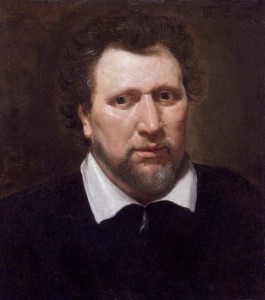On a recent trip to the British Library, I took an idle look at Ben Jonson’s copy of Rabelais’s complete works, in which he made copious notes, in the hope that he would have tried to decipher the nonsensical ‘Antidoted Fanfreluches’, which contain the giant Gargantua’s genealogy and that were discovered in an ancient tomb, in a ‘big, fat, great, gray, pretty, small, mouldy, little pamphlet, smelling stronger, but no better than roses’. While Jonson had dutifully glossed the opening chapters to the book, the ‘Antidoted Fanfreluches’ were understandably left untouched by his hand.
 I did however identify some of Jonson’s notes that other scholars had not spotted before, especially to Rabelais’s catalogue of the Library of Saint-Victor, which contains such learned tomes as The Codpiece of Law and the Art of Farting Politely in Public. Jonson’s marginalia include ‘churnd bollock’, actually a mistranslation of La Couille barine des preux [The Elephantine Penis of the Valiant], and ‘bridle champer’, the latter meaning a lawyer, ‘from his mule, which attending while her master is in court, hath leisure enough to champ on the bridle’ (this from Randle Cotgrave’s Dictionarie of the French and English Tongues (1611), which Jonson clearly had by his side as he took his notes).
I did however identify some of Jonson’s notes that other scholars had not spotted before, especially to Rabelais’s catalogue of the Library of Saint-Victor, which contains such learned tomes as The Codpiece of Law and the Art of Farting Politely in Public. Jonson’s marginalia include ‘churnd bollock’, actually a mistranslation of La Couille barine des preux [The Elephantine Penis of the Valiant], and ‘bridle champer’, the latter meaning a lawyer, ‘from his mule, which attending while her master is in court, hath leisure enough to champ on the bridle’ (this from Randle Cotgrave’s Dictionarie of the French and English Tongues (1611), which Jonson clearly had by his side as he took his notes).
Other gems can be consulted in a note on Jonson’s notes:
Previously Unnoticed Annotations to Jonson’s Copy of Rabelais

Dear Professor Roberts,
I’m a researcher from Moscow, I published the book “Shakespeare: Faces and Masks” (2018) in Russian. In it, I devoted several articles to Jonson’s plays (`Every Man in his Humour`, `Epicoene, or the Silent Woman`, `The Alchemist`).
I am also interested in Rabelais and I have a few questions:
1. Where and when the book by Rabelais that Jonson dealt with was published?
2. Did this edition contain all five books?
3. Is it possible to say that this was the text that we have now and not some preliminary version of the novel?
4. In what years did Jonson read the book and make his notes?
I would be very grateful if you could clear up these questions to me.
Yours sincerely,
Lev Verkhovsky
Dear Lev Verkhovsky,
I apologise for having taken so long to reply to you.
To answer your questions:
1. Les OEuvres de M. Françaois Rabelais, Docteur en Medecine […] (Lyon: Jean Martin, 1599), British Library, 1081.k.2 is the edition in question, with the annotations in it that may be by Jonson.
2. Yes, I believe so.
3. It definitely isn’t a preliminary edition, since Rabelais had been dead for several decades before it came out!
4. The volume contains an inscription ‘The Gift of Beniamin Johnson the Poet to Thos Skynner. 1628’, but it isn’t in Jonson’s hand. Jonson’s annotations show that he was consulting Randle Cotgrave’s Dictionarie of the French and English Tongues (London: Adam Islip, 1611), so my best guess is that he made the annotations sometime between 1611 and 1628.
Yours,
Hugh (Roberts)
Dear Professor Roberts,
Yesterday accidentally looked at your site and saw that you answered my questions almost a year ago. Many thanks!
I would like to inform you that my book “Shakespeare: Faces and Masks” (alas, in Russian) is now fully available on the Web:
http://www.w-shakespeare.ru/library/shekspir-lica-i-maski.html
Several articles in it are devoted to the plays of Ben Jonson. As we know, he liked to use personal satire, to bring his acquaintances to the stage. In the comedy “Episene” I managed to unravel the prototypes of almost all the characters.
Now let me ask you again about Rabelais. Are you sure that the text of the novel (first and second books) that we have now corresponds to the French editions of 1530s? Have copies of those editions survived? If YES, have you seen them in person?
Sincerely,
Lev V.
Yes, there are still plenty of copies of editions of Rabelais from the 1530s and several are available as scans from sources including Gallica, e.g. https://gallica.bnf.fr/ark:/12148/btv1b86000209